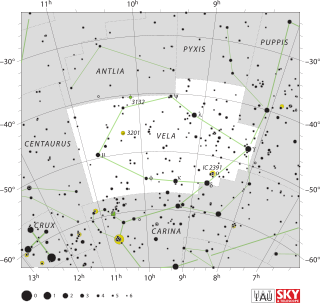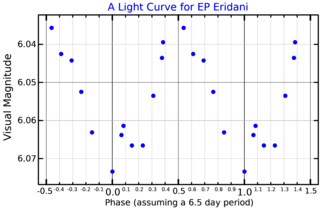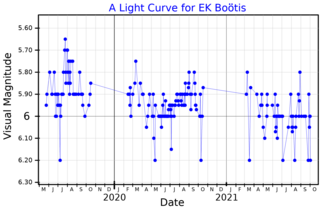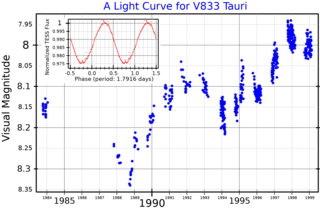Psi Serpentis is a triple star system within the Serpens Caput part of the equatorial constellation Serpens. Based upon an annual parallax shift of 68.22 mas as seen from Earth, it is located approximately 47.8 light years from the Sun. This system came closest approach to the Sun about 585,000 years ago when it made perihelion passage at an estimated distance of 23.27 ly (7.134 pc). Psi Serpentis is faintly visible to the naked eye with an apparent visual magnitude of 5.84.

Psi Velorum, Latinized from ψ Velorum, is a binary star system in the southern constellation of Vela. Based upon an annual parallax shift of 53.15 mas as seen from Earth, it is located 61.4 light years from the Sun. It is visible to the naked eye with a combined apparent visual magnitude of +3.58. The motion of this system through space makes it a candidate member of the Castor stellar kinematic group.

Psi Virginis is a suspected binary star system in the zodiac constellation of Virgo. It can be seen with the naked eye and has an apparent visual magnitude of about 4.8. Based upon the annual parallax shift of 5.99 milliarcseconds, the distance to this star is roughly 540 light years. The angular size of Psi Virginis was measured on December 26, 1975 during an occultation by the Moon, yielding the estimate 6.5±0.3 mas.

14 Aurigae is a quadruple star system located 269 light years away from the Sun in the zodiac constellation of Auriga. It has the variable star designation KW Aurigae, whereas 14 Aurigae is the Flamsteed designation. It is visible to the naked eye as a faint, white-hued star with a combined apparent visual magnitude of 5.01. The system is moving closer to the Sun with a heliocentric radial velocity of −9 km/s.
HD 211415 is a double star in the constellation Grus. With an apparent visual magnitude of 5.33, it is visible to the naked eye. The annual parallax shift is 72.54 mas, which yields a distance estimate of 45 light years. It has a relatively high proper motion, traversing the celestial sphere at the rate of 93.4 mas per year, and is moving closer to the Sun with a radial velocity of −13 km/s.
HD 4628 is a main sequence star in the equatorial constellation of Pisces. It has a spectral classification of K2.5 V and an effective temperature of 5,055 K, giving it an orange-red hue with a slightly smaller mass and girth than the Sun. HD 4628 lies at a distance of approximately 24.3 light years from the Sun based on parallax. The apparent magnitude of 5.7 is just sufficient for this star to be viewed with the unaided eye. The star appears to be slightly older than the Sun—approximately 5.4 billion years in age. The surface activity is low and, based upon the detection of UV emission, it may have a relatively cool corona with a temperature of one million K.

58 Eridani is a main-sequence star in the constellation Eridanus. It is a solar analogue, having similar physical properties to the Sun. The star has a relatively high proper motion across the sky, and it is located 43 light years distant. It is a probable member of the IC 2391 moving group of stars that share a common motion through space.
20 Leonis Minoris is a binary star system in the northern constellation of Leo Minor. It is faintly visible to the naked eye, having an apparent visual magnitude of +5.4. Based upon an annual parallax shift of 66.996 mas, it is located 48.7 light-years from the Sun. The star has a relatively high proper motion and is moving away from the Sun with a radial velocity of +56 km/s. The system made its closest approach about 150,000 years ago when it came within 32.2 ly (9.86 pc).

HD 17925 is a variable star in the equatorial constellation of Eridanus. It has the Gould designation 32 G. Eridani and the variable star designation EP Eri. The star has a yellow-orange hue and is dimly visible to the naked eye in good seeing conditions with an apparent visual magnitude that varies from 6.03 down to 6.08. It is located nearby at a distance of 34 light years from the Sun based on parallax, and is drifting further away with a radial velocity of +18 km/s. It is a likely member of the Local Association of nearby, co-moving stars. The spectrum shows a strong abundance of lithium, indicating that it is young star. This likely makes its point of origin the nearby Scorpio–Centaurus Complex.
HR 9038 is a triple star system located thirty-five light-years away, in the constellation Cepheus. Component A is a spectroscopic binary system with an orbital period of 7.753 days and a combined stellar classification of K3 V. Component B is a red dwarf star that orbits the primary pair every 290 years.

V538 Aurigae is a single star in the northern constellation of Auriga. With an apparent visual magnitude of 6.23, this star requires good dark sky conditions to view with the naked eye. It is located at a distance of 40.0 light-years (12.3 pc) from Sun based on parallax. The star is drifting further away with a radial velocity of 0.9 km/s. It is a member of the Local Association, and is most likely a thin disk star.

HD 130144 is a variable star in the northern constellation of Boötes. It has the variable star designation EK Boötis, while HD 130144 is the designation from the Henry Draper Catalogue. The star is faintly visible to the naked eye with an apparent visual magnitude that ranges from 5.33 down to 5.71. Parallax measurements provide a distance estimate of approximately 810 light years from the Sun. It is drifting closer with a radial velocity of −23 km/s.

HD 106112, also known as CO Camelopardalis, is a star in the constellation Camelopardalis. It has an apparent magnitude of about 5.1, meaning that it is just barely visible to the naked eye. Based upon parallax measurements made by the Hipparcos spacecraft, this star is around 177 light years away from the Sun.

Zeta1 Lyrae, Latinized from ζ1 Lyrae, is a binary star in the northern constellation of Lyra. Based upon an annual parallax shift of 20.89 mas as seen from Earth, the pair are located about 156 light years from the Sun. It is visible to the naked eye with an apparent visual magnitude of 4.37.
78 Ursae Majoris is a binary star system in the northern circumpolar constellation of Ursa Major. It is visible to the naked eye as a faint point of light with a combined apparent visual magnitude of 4.93. Parallax estimates by Hipparcos put it at a distance of 83 light-years (25 pc), but it is drifting closer with a radial velocity of −5 km/s. The system is a candidate member of the Ursa Major Moving Group.

Chi2 Hydrae, Latinised from χ2 Hydrae, is a binary star system in the equatorial constellation of Hydra. Based upon an annual parallax shift of 4.6 mas as seen from Earth, it is located roughly 685 light years from the Sun. It is visible to the naked eye with a combined apparent visual magnitude of about 5.7.

RR Caeli is an eclipsing binary star system, located 69 light-years from Earth in the constellation Caelum. It is made up of a red dwarf star and a white dwarf, which complete an orbit around each other every seven hours. There is evidence of two circumbinary planets orbiting even further away.

IRAS 08544−4431 is a binary system surrounded by a dusty ring in the constellation of Vela. The system contains an RV Tauri variable star and a more massive but much less luminous companion.

HD 283750, also known as V833 Tauri, is a K-type main-sequence star 57 light-years away from the Sun. The star is much younger than the Sun's at 1 billion years. HD 283750 is similar to the Sun in its concentration of heavy elements.













